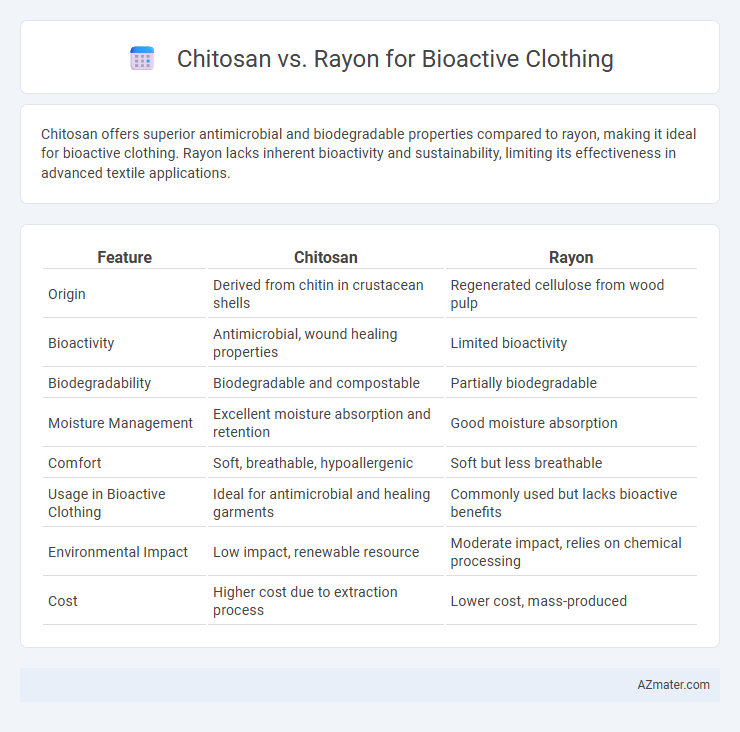Chitosan offers superior antimicrobial and biodegradable properties compared to rayon, making it ideal for bioactive clothing. Rayon lacks inherent bioactivity and sustainability, limiting its effectiveness in advanced textile applications.
Table of Comparison
| Feature | Chitosan | Rayon |
|---|---|---|
| Origin | Derived from chitin in crustacean shells | Regenerated cellulose from wood pulp |
| Bioactivity | Antimicrobial, wound healing properties | Limited bioactivity |
| Biodegradability | Biodegradable and compostable | Partially biodegradable |
| Moisture Management | Excellent moisture absorption and retention | Good moisture absorption |
| Comfort | Soft, breathable, hypoallergenic | Soft but less breathable |
| Usage in Bioactive Clothing | Ideal for antimicrobial and healing garments | Commonly used but lacks bioactive benefits |
| Environmental Impact | Low impact, renewable resource | Moderate impact, relies on chemical processing |
| Cost | Higher cost due to extraction process | Lower cost, mass-produced |
Introduction to Bioactive Clothing
Bioactive clothing incorporates materials that interact with the skin to provide health benefits, often using natural or synthetic fibers with antimicrobial, anti-inflammatory, or healing properties. Chitosan, a biopolymer derived from chitin, offers strong antibacterial and biocompatible characteristics, enhancing wound healing and skin protection in wearable textiles. Rayon, a semi-synthetic fiber made from regenerated cellulose, provides softness and breathability but lacks inherent bioactive features compared to chitosan-based fabrics.
Understanding Chitosan: Origins and Properties
Chitosan, a natural polysaccharide derived primarily from the shells of crustaceans like shrimp and crabs, exhibits exceptional biocompatibility and biodegradability, making it ideal for bioactive clothing applications. Its intrinsic antimicrobial properties and ability to promote wound healing stem from its positive charge, which interacts effectively with microbial cell membranes. Compared to rayon, a semi-synthetic cellulose fiber, chitosan's bioactivity and sustainability credentials provide enhanced functional benefits in bioactive textile innovations.
Rayon: Composition and Key Features
Rayon, a semi-synthetic fiber derived from cellulose, offers excellent moisture absorption and breathability, making it ideal for bioactive clothing applications. Its smooth texture enhances comfort while its compatibility with various bioactive treatments, such as antimicrobial or antiviral agents, supports health-focused textile innovation. The fiber's biodegradability and ability to blend well with natural and synthetic fibers contribute to sustainable and multifunctional fabric solutions.
Biocompatibility: Chitosan vs Rayon
Chitosan exhibits superior biocompatibility compared to rayon, making it highly suitable for bioactive clothing that interacts closely with the skin. Its natural polysaccharide structure promotes cell adhesion and accelerates wound healing without causing irritation or allergic reactions. Rayon, being a semi-synthetic fiber, lacks inherent bioactivity and may cause skin sensitivity issues, limiting its effectiveness in bioactive textile applications.
Antimicrobial Efficacy in Bioactive Clothing
Chitosan exhibits superior antimicrobial efficacy compared to rayon in bioactive clothing due to its inherent biopolymer structure that disrupts microbial cell membranes and inhibits bacterial growth. Rayon, primarily a cellulose-based fiber, lacks intrinsic antimicrobial properties and often requires chemical treatments to achieve similar bioactivity. The incorporation of chitosan into textiles enhances long-lasting antimicrobial protection, making it a preferred material for functional, hygienic bioactive clothing.
Moisture Management and Comfort Comparison
Chitosan fibers exhibit superior moisture management by effectively absorbing and releasing sweat, enhancing breathability and dryness in bioactive clothing compared to rayon, which tends to retain moisture and slow evaporation. The antimicrobial properties of chitosan further improve comfort by reducing odor-causing bacteria, while rayon's comfort relies more on its soft texture but lacks inherent bioactive benefits. Consequently, bioactive garments utilizing chitosan provide enhanced comfort through balanced moisture control and hygienic performance.
Environmental Impact: Sustainability and Biodegradability
Chitosan, derived from chitin found in crustacean shells, offers superior sustainability and biodegradability compared to rayon, which is typically produced from chemically processed wood pulp. Chitosan's natural origin and biodegradation in marine and soil environments reduce environmental pollution, whereas rayon production involves toxic chemicals and generates substantial industrial waste. The eco-friendly profile of chitosan enhances its suitability for bioactive clothing aimed at minimizing ecological footprints and promoting circular textile economies.
Applications in Medical and Everyday Apparel
Chitosan, derived from crustacean shells, offers superior antimicrobial and biocompatible properties compared to rayon, making it ideal for medical textiles such as wound dressings and infection-resistant garments. Rayon, a semi-synthetic fiber from cellulose, excels in breathability and softness, suitable for everyday apparel but lacks inherent bioactivity. The combination of chitosan's bioactive functionality with rayon's comfort properties is revolutionizing bioactive clothing in both healthcare and casual wear sectors.
Cost and Manufacturing Considerations
Chitosan fibers offer biodegradable and antimicrobial properties, enhancing bioactive clothing's functionality but come with higher production costs due to complex extraction and processing methods. Rayon is more cost-effective and widely available, benefiting from established manufacturing infrastructure but lacks innate bioactivity, often requiring chemical treatments to achieve similar effects. Cost-efficiency in manufacturing favors rayon, while chitosan's superior biofunctional advantages justify its premium in specialized applications.
Future Prospects for Chitosan and Rayon in Textile Innovation
Chitosan, derived from chitin in crustacean shells, offers promising bioactive properties such as antimicrobial activity and biodegradability, positioning it as a sustainable alternative in advanced textile applications. Rayon, chemically regenerated cellulose fiber, provides versatility, softness, and moisture absorbency, maintaining a critical role in sustainable fashion by blending comfort with future eco-friendly innovations. The future of textile innovation lies in hybridizing chitosan's functional bioactivity with rayon's environmentally adaptable fibers, enabling smart fabrics with enhanced health benefits and reduced environmental impact.

Infographic: Chitosan vs Rayon for Bioactive Clothing
 azmater.com
azmater.com